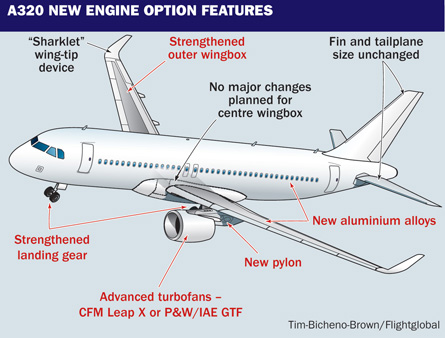Airbus aims to avoid any temptation to add complexity to its proposed "A320 new engine option (NEO)" upgrade to ensure it will achieve its 2015 service-entry target. However, it looks unlikely that a launch decision for the re-engined derivative will be made until the end of the year.
Airbus is in talks with CFM International and Pratt & Whitney about offering their advanced turbofans, the Leap X and geared turbofan, respectively, on the A320.
It does not envisage any all-new single-aisle being viable before 2025, and the airframer's executive vice-president programmes Tom Williams believes that if Boeing was to make such an aircraft available by the end of this decade it would be obsolete in less than 10 years, when breakthrough technologies such as open rotors mature.

But despite hints from Seattle that such a move is being considered, Williams is determined not to let this influence the definition of the A320 NEO, which is envisaged as being little more than a re-engined version of the current aircraft.
"I want to avoid being sucked into the A350 scenario again, which started out as an A330 re-engining," he said at the Airbus Innovations Days event at its Broughton, UK plant, which was held on 10-11 May. "Airbus needs to be disciplined and not to have scope creep" with the A320 NEO, he added.
Williams believes that Airbus and the engine makers have a "window of opportunity to exploit" with the A320 NEO, and moves to complicate the offering could cause the planned 2015 in-service date to slip and therefore jeopardise the business case for the aircraft.
Williams estimates that an all-new single-aisle would cost $10 billion to develop, around four times that estimated for an upgrade programme such as the A320 NEO.
With Airbus still scrutinising the business case study into the NEO, both Williams and Airbus's chief salesman John Leahy played down earlier talk that the decision to launch could come by as early as the Farnborough air show in July. "We'll launch it when we're ready," says Williams, with the target to make a decision by year-end.
Airbus has been examining the structural changes necessary to accommodate the installation of new engines, but its aim is to keep these to a minimum. Williams says that the new engines are potentially "600-800lb [270-370kg] heavier" than today's CFM56 and International Aero Engines V2500 powerplants. Their higher thrust and bigger inlets would also "give us some issues aerodynamically - wing bend and twist etc".
This will mean the outer wing will need reinforcing, but Williams says the hope is that Airbus "won't have to do too much to the centre wingbox".
Although Airbus aims to continue to offer the current engines in parallel with the NEO, Williams says that ideally production would be standardised around the heavier, reinforced wing as this is "the simplest and preferred option from an industrial standpoint".
The first official image released by Airbus of the A320 NEO reveals that the wingtips will incorporate the new "sharklet" winglet design, as expected.
Despite the new engines' higher thrust, Williams says that studies indicate that it would be unlikely there would be any need to enlarge the fin or tailplane to compensate for engine-out operations.
Another area that will need attention is the landing gear and Williams says that while studies into the sizing are ongoing, the aim is to "avoid a significant change".
No significant material changes are envisaged to save weight, says Williams, although Airbus may "take advantage" of new aluminium alloys that have been used in the A380.
Williams says that while from a technical perspective the GTF might be the better option as it fan-drive gearbox layout makes it more obvious where its performance gains come from, he sees the commercial argument as less strong because of P&W's weak position in the small-engine market. "Up to now they've accessed that market through IAE. We'd like them to keep the IAE relationship but for the moment the partners can't find a way to do that," he says.
However, Williams says that if agreement cannot be reached by the IAE partners, then Airbus "would countenance doing a separate deal with P&W", for its GTF.
P&W's IAE partner Rolls-Royce is not in the running as prospective supplier for the A320 NEO, says Williams. "We don't think they've got a solution that works for re-engining. We've had a lot of discussions but none of their ideas work for a re-engining programme from a technical or commercial point of view."
Source: Flight International
















